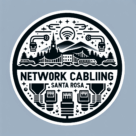What Is the Fastest Network Cable? A Complete Guide to High-Speed Connectivity
If you’ve ever wondered what the fastest network cable is for your home or business, you’re not alone. As internet speeds and data demands continue to grow, choosing the right Ethernet cable can make all the difference in how efficiently your devices communicate. From online gaming to streaming and enterprise networking, the right cable determines how much speed and reliability you can actually use.
This guide breaks down the fastest network cables available today, how they work, and what to consider before upgrading your cabling system. Our team of professional network cabling experts in Santa Rosa ensures high-performance connectivity with the latest cable technologies.
Understanding Network Cable Categories
Network cables, commonly known as Ethernet cables, are classified by “Category” (or Cat for short). Each category represents a different level of speed, bandwidth, and shielding design. The most common types include:
- CAT5e: Supports speeds up to 1 Gbps (Gigabit Ethernet) and bandwidth up to 100 MHz.
- CAT6: Handles up to 10 Gbps for shorter distances (up to 55 meters) with 250 MHz bandwidth.
- CAT6a: Enhanced version of CAT6, supporting 10 Gbps at 100 meters and 500 MHz bandwidth.
- CAT7: Supports up to 10 Gbps at 100 meters with improved shielding and 600 MHz bandwidth.
- CAT8: The fastest copper Ethernet cable available, supporting up to 40 Gbps at 30 meters with 2000 MHz bandwidth.
Each upgrade in category improves performance by reducing interference (crosstalk) and allowing higher frequencies, which means faster data transfer.
The Fastest Network Cable Available Today: CAT8
Currently, the CAT8 Ethernet cable holds the title for the fastest copper-based network cable. Designed for data centers and high-performance networks, CAT8 can deliver up to 40 Gbps at a maximum distance of 30 meters.
Here’s what makes CAT8 the best in class:
- Speed: 4x faster than CAT6a cables.
- Frequency: Operates at 2000 MHz for lightning-fast data transmission.
- Shielding: Individually shielded twisted pairs (S/FTP) reduce interference and signal loss.
- Compatibility: Backward compatible with CAT7, CAT6a, and CAT6 cables.
While CAT8 offers incredible performance, it’s typically used in server rooms, data centers, and enterprise networks. For homes and small businesses, CAT6a or CAT7 is usually more than enough.
Fiber Optic Cables: Even Faster Than Copper
If you want to go beyond copper Ethernet speeds, fiber optic cables are the next level. Fiber cables use light to transmit data, offering nearly unlimited bandwidth potential and extremely long-distance capability.
The two main types of fiber cables are:
- Single-mode fiber (SMF): Best for long-distance communication — can reach up to 25 miles with speeds exceeding 100 Gbps.
- Multi-mode fiber (MMF): Ideal for shorter distances (up to 500 meters), with speeds up to 40–100 Gbps.
Fiber optics are the fastest network cables in existence, but they’re more expensive to install and maintain compared to copper options. That’s why fiber is typically reserved for backbone cabling, ISPs, and enterprise-level networks.
Comparing Cable Speeds and Use Cases
| Cable Type | Max Speed | Max Distance | Typical Use |
|---|---|---|---|
| CAT5e | 1 Gbps | 100m | Home networks, basic office setups |
| CAT6 | 10 Gbps | 55m | Small businesses, gaming, streaming |
| CAT6a | 10 Gbps | 100m | Professional offices, smart homes |
| CAT7 | 10 Gbps | 100m | Data-heavy business networks |
| CAT8 | 40 Gbps | 30m | Data centers, server connections |
| Fiber Optic | 100+ Gbps | Up to 25 miles | Internet backbones, enterprises |
Which Cable Should You Choose?
Choosing the right network cable depends on your needs, equipment, and future goals:
- For everyday home use, CAT6 is affordable and fast enough for most internet plans.
- For business or gaming, CAT6a offers 10 Gbps with better shielding.
- For data centers or server setups, CAT8 or fiber optic cabling is the ultimate choice.
If you’re planning new network infrastructure, consider future-proofing your installation. Installing CAT6a or CAT8 structured cabling now means you won’t need another upgrade for many years.
Why Professional Installation Matters
Even the best cable won’t perform at its full potential without proper installation. Professional network cabling experts ensure your cables are correctly terminated, labeled, and tested according to industry standards such as ANSI/TIA-568.
Hiring certified installers helps you:
- Maximize speed and performance
- Ensure compliance with local codes
- Avoid costly signal interference
- Keep your network organized and scalable
Whether for homes, offices, or data centers, proper setup is key to getting the most out of high-speed cabling.
The Future of Network Speeds
As technology advances, so does cabling. We’re already seeing experimental standards beyond CAT8, as well as fiber solutions capable of terabit-level speeds. With 5G, cloud computing, and IoT growth, structured cabling will remain the core of every fast, connected system.
If you’re planning to upgrade, investing in CAT6a, CAT7, or fiber optic cabling ensures your network will keep up with the next decade of digital innovation. Different cables offer varying data transmission speeds. Learn more about what type of cable is used for internet to understand which one suits your connection needs.
Final Thoughts
The fastest network cable today depends on your specific needs:
- CAT8 for top copper speeds
- Fiber optic for the ultimate performance over long distances
For most users, CAT6a provides the perfect balance between speed, cost, and future-readiness. To get the best results, work with a licensed structured cabling contractor who can assess your setup and recommend the most efficient solution.
